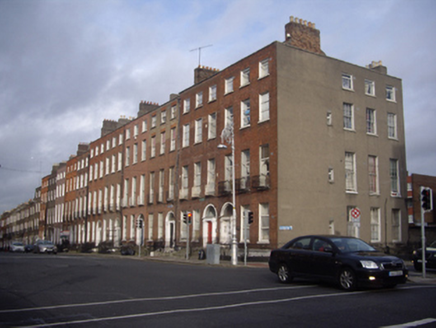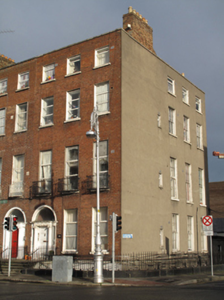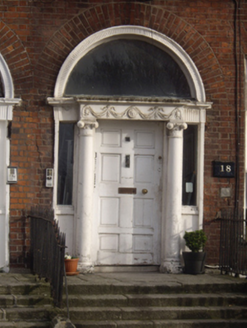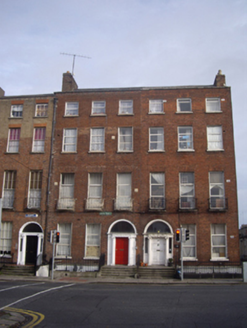Survey Data
Reg No
50010799
Rating
Regional
Categories of Special Interest
Architectural, Artistic
Original Use
House
In Use As
Apartment/flat (converted)
Date
1795 - 1805
Coordinates
316107, 235554
Date Recorded
18/11/2011
Date Updated
--/--/--
Description
End-of-terrace corner-sited three-bay four-storey house over exposed basement, built, c.1800, as pair with No. 17 to north and forming external corner of east side of Mountjoy Square. Now in multiple occupancy. Double-pile asbestos tiled roof with pair of pitches set perpendicular to rear, that to north shared with adjoining house. Brick chimneystack to south gable and rendered chimneystack to rear gable, both having clay pots. Roof hidden behind rebuilt parapet wall with granite coping. Red brick walls laid in Flemish bond to granite plinth course above roughcast rendered basement walls. Cement rendered side and rear elevations with granite coping to parapet. Gauged brick flat-arched window openings with flush rendered reveals, painted granite sills and mainly replacement uPVC windows. Original wrought-iron balconettes to first floor windows and iron grilles to basement windows. Early replacement six-over-six pane timber sliding sash windows to south side elevation and two round-headed stair hall window openings to rear elevation with spoked upper sashes retained. Gauged brick round-headed door opening with fluted reveal and painted stone Ionic doorcase, and original timber door with eight raised-and-fielded panels flanked by engaged Ionic columns on plinth bases supporting stepped lintel cornice with swag motifs and plain fanlight. Door opens onto shared granite platform divided by original wrought-iron railing to north, integrated bootscraper to south railing and five granite steps bridging basement. Basement area enclosed by original wrought-iron railing and cast-iron corner posts set on moulded granite plinth wall, returning to enclose south side elevation in curved sweep. Roughcast rendered red brick boundary wall to Fitzgibbon Street with timber pedestrian door, ESB sub-station and two single-storey flat-roofed shop units.
Appraisal
This house, one of a pair, has retained much of its Georgian character in its form, fenestration pattern and general appearance. It retains an early panelled door and a fine doorcase which provides a decorative focus, not just for the house but also for the junction formed by Mountjoy Square and Belvidere Place. It constitutes an important part of a coherent terrace, the building providing examples of the subtle variations that contribute to the architectural interest on this most uniform of Georgian squares. The retention of the plinth and railings to the plinth, in this case rounding the end of the terrace, is important for the setting of the building, and for the intactness of the general streetscape. Mountjoy Square was built on lands formerly belonging to Saint Mary’s Abbey, laid out in 1790 by Luke Gardiner II and complete by 1818. Originally called Gardiner Square the plan was to develop a strong vista from Custom House to Mountjoy Square. Unlike other Georgian squares in the city, this example was more carefully laid out with a unified parapet height and the east-west approaches offset to create a sense of enclosure. After falling into serious neglect and dereliction throughout the twentieth century resulting in the loss of one third of its original buildings, the square has since been rebuilt.







